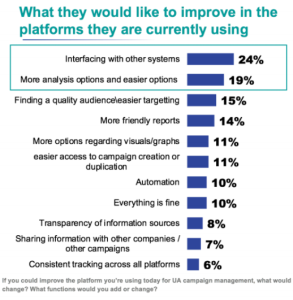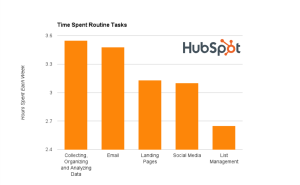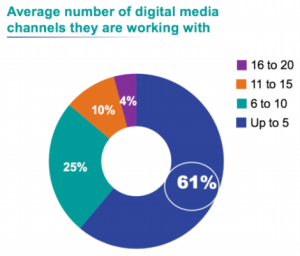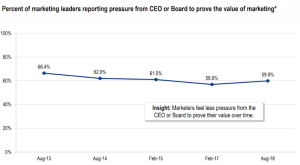When it comes to your media planning, diversification is a key element to maintaining a steady activity of your marketing plan. But why not centralize it all into one screen, from various channels to create a better, more efficient, less time-consuming, and clearer workflow for your campaign management team?
We’ve all heard the saying, “Don’t put all your eggs in one basket.” Usually, diversification is important. It’s true in the investment world, where it’s advised to have a mix of assets and stocks. And it’s true in advertising.
When you want to reach a big volume of potential users and reach a large audience for your mobile app, you know you won’t find them all in one channel, in a single space. Therefore, you mix your user acquisition media plan and spread your efforts across different channels.
According to Appsflyer, different advertisers are using different number of sources, all depending on budgets and app vertical.
But the challenge is that managing a wide range of user acquisition campaigns across 6 (or, you know, 20) channels can take your whole day, and keep you away from the deep data analysis that can set you to success.
It doesn’t have to be this way.
A Day in the Life of a Performance Marketer
Creating the campaign, setting your targeting (age, location, preferences, etc) can take hours, as you’re working on each platform separately, doing the same meticulous process on each source. Then, optimizing each one can take you days on ends, depending on your budget, amount of campaigns per devices and geos.
Next comes the campaign analysis part, which is usually a lot of fun.
If you’re a data enthusiast like us, you can literally do it all day. Sometimes you find yourself going deep into a micro view of each day, analyzing why one weekend was better than the other (our guess, it must have been that new set of banners that gave the regular weekend campaign a boost).
Except now you have to analyze all your campaigns, across 6 (or, you know, 20) channels, and somehow align the measurement standards, KPIs and audience targeting that each channel offers into one cohesive data source, that helps you make smarter decisions on future campaigns to grow your app.
Long hours at the (home) office?
Us too.
That was our story for years, as we manually managed campaigns for some of the largest brands in the world.
Until we realized that, even though all the experts said “don’t put all your eggs in one basket,” there’s got to be a way to watch, analyze and control all the campaign data, from all channels, in one screen.
You know, that whole “work smarter, not harder” mantra.
We couldn’t find something that served our needs, so we ended up building it from scratch ourselves. The process taught us a lot. Among others, it taught us that, sometimes, one has to go against common advice, and actually put all of one’s advertising eggs in one basket if one wants to truly scale one’s app.
Marketers are Wasting 184.6 Hours a Year
In a global study we conducted among over 70 international marketing and user acquisition professionals in 2020, the second most desired improvement to current user acquisition campaign management platforms was “more analysis options and easier options.”

Source: Zoomd Research, 2019
This isn’t surprising considering how much time marketers spend “collecting, organizing and analyzing marketing data from different sources” – “an average of 3.55 hours a week,” according to a HubSpot survey.
That’s 184.6 hours a year, the equivalent, more or less, of a full month of work.
Source: HubSpot
The HubSpot survey was conducted in 2015, and marketers are still struggling with this. That’s because they still believe following common advice to spread your app advertising resources is the best way to go.
They’ve got a radio ads provider, a TV ads provider, a Facebook ads provider, a TikTok ads provider, and let’s not even begin to count the amount of app advertising networks that are out there.
39% of our survey responders told us they work with 6 or more digital media channels. 14% work with 11 or more, and some – with 16-20 channels.

Source: Zoomd Research, 2019
That means logging in and out of 6 or 20 channels every day, reviewing that many dashboards, and figuring out a way to not only analyze each channel’s data, but how they correspond with one another too.
True, it’s important to diversify app download resources and not rely on one advertising channel. But there are just so many dashboards a person can analyze, and then somehow unify manually, to get all data from all channels to make one cohesive sense.
Even though managing so many channels separately is the common thing to do, it’s costing companies a lot of money.
The Cost of Waste, and What You Can Do About it
If the average marketer spends 3.55 hours a week collecting, organizing and analyzing data from different sources, what is it costing the organization?
A median salary of a marketing manager in 2019, according to the US Bureau of Labor Statistics, was estimated to be $136,850. The median hourly rate was estimated to be $65.79.

Source: US Bureau of Labor Statistics
That means companies’ investment in data collection, organization and analysis for their apps could be estimated at $233.55 a week – or $12,144.83 a year.
That’s assuming you only have one person in charge of it, and that person’s not ranked higher or earning a higher salary. We know that many times, companies have multiple people in charge of this part of the department.
We’ve also seen marketers who invest a lot more hours every day on these tasks.
Now, some employee time will need to keep being allocated to analyzing your app advertising efforts, so you can make smarter and smarter decisions each time.
But companies can easily save a five-figure amount across multiple team members doing this work – without hurting their salaries. They could reinvest marketers’ time in more revenue-generating activities than hopping between dashboards and trying to optimize each one separately if they just unified and simplified their app marketing operations.
We’ll talk about how you can do that in a bit. But let’s first focus on the people who turn your strategy into reality, because the time cost is just the beginning.
Simplifying your team’s work, and refocusing it on more satisfying aspects than data collection, also serves to prevent burnout. Preventing burnout means you get more productive employees, who perform better and stay on the job longer, saving you recruitment costs.
According to a 2020 Gallup survey, 21% of employees experience burnout very often. And sure, part of it is how many hours we all work, “but how people experience their work has a stronger influence on burnout than hours worked,” explained Gallup.
Burnout is bound to lead to lower engagement. According to Good & Co, “companies with low engagement scores saw operating income decline by 32.7%.”
At the same time, approximately 60% of marketing leaders have felt the pressure from their CEO or board to prove their department’s value to the company’s bottom line for years now, according to Econsultancy.
Source: Econsultancy

That number is likely higher now, with everything happening in the global economy due to COVID-19.
Getting your team to work the same hours, but drive better results for your app, is more critical than ever.
These are going to be the people that will get promoted and get pay increases despite the economic situation. These are going to be the departments that gain budget increases and are able to make a bigger impact for their apps and their customers.
Unifying Channels Means More Profitable Mobile User Acquisition Campaigns
The common advice to avoid keeping all your eggs in one app advertising basket doesn’t necessarily decrease your risk. In fact, it increases it.
And not just because it’s frustrating your team and making their work harder than it needs to be.
Remember that global survey we conducted recently?
The number one thing marketers told us they’d like to add to the user acquisition management platforms they use is the ability to interface with other systems.
And 60% told us they’d like the ability to watch, analyze and control all the campaign data from all channels, in one screen.
But we’d like you to dream even bigger than that – and consider unifying cross-channel data as well.
Why?
Because when you manage your app UA campaigns in channel silos, you become dependent on certain platforms that provide better data. Simultaneously, you end up settling for less efficient data and app growth through other channels in the name of a wider distribution.
Instead of simply unifying channels and data.
If Facebook offers you better targeting options now, and changes its mind tomorrow, what will you do? And what about all the app downloads you’re leaving on the table due to poor targeting on other channels?
The truth is it’s not your fault. You educate yourself, you practice what you learn, and you show up for your team. You do everything you can to generate app growth.
We see this when we talk to marketers like you every day.
All the gurus – and many “best practices” articles – recommend managing app marketing channels separately from one another.
As performance marketers, we subscribed to that belief for a long time too. But when we decided to create a better way, everything changed.
When we unified all our mobile user acquisition channels into one SaaS platform, time management became easier, still running in all the channels we wanted and many more…because the same work took us much less time. We still use a ton of channels – the platform we built unifies over 600 global media sources – but we see everything on one clear dashboard.
No more spending hours upon hours collecting and organizing data.
The analysis has gotten simpler as well, and generating app downloads is just easier.
That’s because we’ve unified our data. Among others, we’ve partnered with premium social platforms, including Google, , Facebook, Instagram TikTok, Apple search ads and Snapchat. As a result, we’ve been able to use one channel’s data to influence our app advertising campaign on other channels.
The platform learns what works on a certain channel, automatically compares it to what’s worked on others, and creates predictive suggestions, that increase app downloads even on less robust channels.
You Can Have Your Cake and Eat it Too
In her book, The Happiness Project, author Gretchen Rubin says she wanted to change her life without changing her life. She wanted to make enough small changes to experience greater levels of happiness, even though she already had a lot to be thankful for.
By unifying your dashboards and data, you can do the same. You can keep doing your usual work, and keep spreading your budget across a wide variety of channels.
You can also see exactly what drove impressions, clicks and app downloads on each channel separately, and how much each action cost.
But you can see it all on one dashboard. You get better insights without wasting your time on data collection. And you make smarter, more accurate targeting since you get unified, deeper data from 600+ sources.
So, ultimately, you get more app downloads and more in-app sales for less work and hassle.
That’s what we set out to provide for you with our new SaaS platform, and we’re excited to invite you to try it.
Pave Your Own Way
Just because everyone does the same thing, it doesn’t mean we need to follow along too. It is many times, those who go against the grain that make the biggest splash, the biggest impact, and enjoy the biggest rewards.





